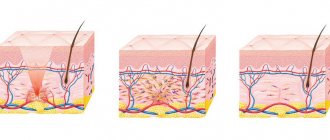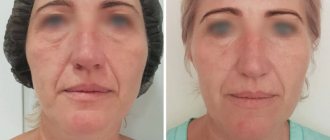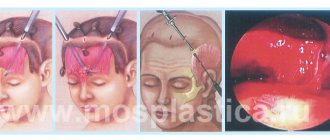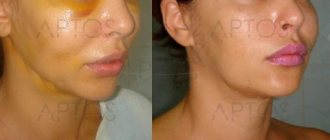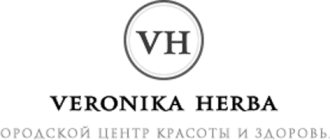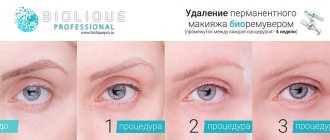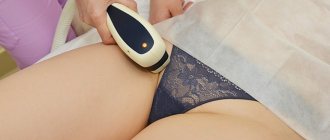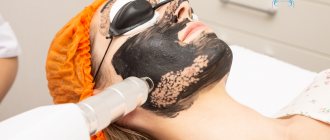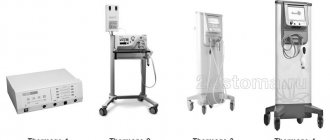Sign up for the procedure
After 30-35 years, cellular renewal processes in our skin sharply slow down, and the production of collagen and hyaluronic acid decreases. This is why we see the first wrinkles, age spots, and dull complexion in the mirror. Nowadays, few people are ready to put up with such changes. Of course, you can disguise wrinkles with “beauty injections”, and hide uneven skin color under a thick layer of foundation. However, there is a fundamentally different solution - laser rejuvenation. What's the difference? The fact is that the laser rejuvenation procedure allows you to completely renew the skin at the dermis level. One of the most modern devices that implement this technology is the M22 platform, equipped with a ResurFX laser module.
The action of the ResurFX laser is based on the technology of fractional skin remodeling at the dermal level, which is recognized as the largest discovery in laser cosmetology over the past 15 years and the “gold standard” of rejuvenation throughout the world. Fraxel laser rejuvenation became widely known thanks to the Fraxel device, but the ResurFX laser, developed after it, is supplemented with its own proprietary technologies for robotic control of the laser beam. Our clinic was created by the official distributor of the M22 device in Russia, so you can be sure that you will get the best results and the highest level of safety.
Operating principle
Laser equipment can be schematically represented in the form of three main elements: a pumping mechanism, a working fluid and an optical cavity.
The first element is the pumping mechanism
, or, in other words, the energy source that launches the laser working fluid. The source of laser radiation determines one of the most important characteristics of the laser - the wavelength of the radiation. There are a wide variety of lasers on the market today. Among them are erbium, neodymium, CO2 lasers, as well as diode, or, as they are also called, semiconductor lasers. They all have different pumping mechanisms.
The second element is considered to be the working fluid
, which determines the laser wavelength, narrow focus, monochrome and other properties of the device. The working medium for fractional lasers can be solids (crystals, alloys, semiconductors), liquids (dye solutions) or gases (CO2, halogens, gas mixtures).
| Working fluid | Examples |
| Solid-state lasers (crystals, glass) | Ruby crystals consisting of aluminum oxide interspersed with chromium atoms in the crystal lattice Neodymium YAG laser (Nd:YAG; Er:YAG) Laser on glass Er:Glass |
| Gas lasers | Carbon dioxide (CO2) Argon Copper vapor |
| Liquids | On inorganic or organic dyes |
| Semiconductor | Diode |
The third element is the optical resonator
.
The light wave, reflected from the mirrors (optical resonator
), returns to the active medium, exciting new atoms. According to this avalanche-like principle, the energy of the laser beam is amplified. Typically, a partially transparent mirror is used on one side to thereby ensure that the radiation exits into the light guide. Typically, more complex lasers use four or more mirrors. It is their quality and installation that largely determine the quality of the entire laser system.
How does the procedure work?
- At the preliminary consultation, the doctor assesses the skin condition using 3D diagnostics on the Antera Pro device (if necessary).
- Immediately before the procedure, the skin is cleaned of makeup and an anesthetic ointment is applied to the skin for 40–60 minutes.
- During the procedure, the doctor slowly moves the device's manipulator over the skin, carefully working on each area.
- The patented CoolScan scanning technology implemented in the ResurFX laser with contact cooling protects the skin and makes the procedure as comfortable as possible by cooling after each flash. During operation of the device, the patient feels warmth and a tolerable tingling/burning sensation.
- The duration of the procedure is on average 20–30 minutes, depending on the area of the treated area.
- Upon completion, the doctor applies a soothing cream to the patient’s face and gives recommendations for home care. For a month, you should moisturize your skin daily and use a cream with a high SPF level.
- The number of procedures required for a pronounced rejuvenation result is determined by the doctor during consultation. As a rule, the course consists of 3-5 procedures with an interval of at least 4 weeks.
Which fractional lasers to buy for a beauty salon?
The main technical parameters that distinguish fractional lasers are: power, wavelength, percentage of coverage. Most often, radiation power is determined in watts or joules. You can determine whether equipment belongs to VILI using the hazard class of laser equipment. This is stated in the documents of the State Standard of the Russian Federation GOST R IEC 60825-1-2009 “Safety of Laser Equipment” and SanPiN 2.1.3.2630-10 “Sanitary and Epidemiological Requirements for Organizations Carrying Out Medical Activities”. According to the laser safety standard, devices are divided into 7 classes in ascending order: 1, 1M, 2, 2M, 3R, 3B and 4. Manufacturers usually write information about laser safety on the body of the device. It is known that all CO2 lasers belong to class 4, and any laser capable of burning tissue has a class of at least 3B.
The second important characteristic of fractional lasers is wavelength. The maximum wavelength of fractional lasers is: 10,600 nm (CO2 lasers), 1550 nm, 2940 nm (erbium lasers), 1064 nm (neodymium lasers). Diode lasers can be designed at any wavelength. But each procedure has its own optimal indicators.
Wavelength is the physical distance between the peaks of successive waves in a laser beam. Wavelength is measured in nanometers (10-9 meters, nm) or micrometers (10-6 meters, or 10-3 millimeters, microns). One nanometer is equal to 0.001 micrometer.
The third characteristic is the percentage of coverage, that is, the sum of the areas of all photothermolysis or ablation microzones divided by the area on which they are formed. This most important parameter determines not only the effectiveness, but also the safety of the procedure. The percentage of coverage largely depends on the type of radiation and working attachments.
The basic package of fractional lasers includes: a system unit with a certain type of laser and installed modules, a mirror manipulator (it is worth noting that many non-ablative fractional lasers use flexible optical fiber instead of a mirror manipulator; its advantage is that it is much lighter and thinner, but there is the risk of frequent breakdowns, and its replacement can be expensive; the articulated arm is more durable to use, but less convenient due to the need for adjustment and calibration), a nozzle with an adjustable focal length and a built-in ablation product evacuation system, safety glasses, user manual (in Russian language) and instruction manual (in Russian).
How it works
ResurFX works using a non-ablative fractional photothermolysis method. Its essence is the creation of microzones on the skin with a laser, between which islands of undamaged tissue remain. Inside these microzones, the process of cell regeneration starts and new collagen is formed. In one procedure, up to 20% of the skin surface is damaged, and the remaining 80% ensures rapid recovery. Thus, with each subsequent procedure, the old collagen framework is replaced by a new one, resulting in renewed, youthful skin. This principle ensures that the procedure is atraumatic and has a short rehabilitation period.
A little history
The history of the laser (an abbreviation for the English Light Amplification by Stimulated Emission of Radiation: amplification of light using induced (stimulated) radiation
) began in 1916, when Albert Einstein developed the theory of the interaction of radiation with matter. During his work, the great scientist suggested the possibility of creating quantum amplifiers of electromagnetic waves. Such an amplifier, designed by N. Basov and A. Prokhorov, enabled the physicist T. Meiman to create the first ruby laser in 1960, which served as an impetus for the development of laser medicine. Five years later, surgeon Leon Goldman removed the first tattoos with a similar laser. In 1983, American scientists Rox Anderson and John Parrish published their concept of selective photothermolysis in the journal Science, after which laser medicine and dermatology experienced a real revolution.
Advantages
- Deep rejuvenation at the dermis level.
- Maximum gentle impact. ResurFX allows for laser rejuvenation of facial skin, including the delicate area around the eyes.
- Low morbidity. Laser exposure does not damage the stratum corneum of the epidermis and does not disrupt the barrier functions of the skin.
- Predictable result. During each procedure, about 20% of the skin is renewed.
- Versatility. The procedure using the ResurFX laser is used on all areas of the face, neck and décolleté, hands and the whole body; on skin of any shade and type, even the most sensitive.
- No side effects.
- Minimum rehabilitation period. The very next day after the session you will be able to return to your normal rhythm of life.
Laser rejuvenation
From the previous article “Laser in cosmetology” you remember what chromophores are and that they are different for each “defect” of the skin. For rejuvenation, the target chromophore is water. Why water? Because water deposits are located in the dermis, in the same place where fibroblasts are located, synthesizing the main supporting proteins and elements of the intercellular matrix necessary for skin elasticity, including the famous hyaluronic acid.
Today, clinics offer us three main options for laser therapy.
Non-ablative effects: tone and rejuvenation
What is this:
Non-ablative means the epidermis is not damaged and this technique has a high degree of safety. Basically, the procedures are indicated for the first stage of aging (small wrinkles, slight loss of turgor), post-acne, etc. As a rule, they are prescribed in a course (3-8 procedures) and are recommended for young patients - up to 35-40 years. As a result, sebum secretion decreases, pores become smaller, the level of moisture increases, microcirculation improves, which means post-acne has a chance to resolve, and acne scars smooth out. Overall, you will look fresh and fit.
How it works:
The laser beam “warms” the skin to the point where proteins, such as collagen, are denatured, resulting in the activation of the production of new protein, as well as other components of the extracellular matrix. That is, the effect is only on the deep layers of the skin, and on the surface the temperature does not exceed 40–48 degrees and no damage occurs.
What kind of laser is needed:
The most popular here are diode lasers with a wavelength of 1064 nm (Nd:YAG), 1540 nm (Er:Glass).
Ablative effect. Grinding
What is this:
Ablative means damage to the epidermis occurs and tissue is removed. This is certainly one of the most effective methods, since after the procedure a complete restart of the system occurs, i.e. the skin begins to work like “10 years ago”, the structure of the dermis is completely remodeled.
Actually, there is only one downside to this, but what is it? During the procedure, you are simply “skinned off.” This is an open wound with all the ensuing consequences (pigmentation, the possibility of infection, bleeding crusts, necrosis) and rehabilitation within a month. The selection of patients for such a procedure is very serious, you will not get such an execution just like that. But if you have hyperkeratosis, the oval of your face has already completely swollen and all the signs of aging have been on your face for a long time - you are a candidate for resurfacing.
How it works:
By absorbing laser energy, water turns into water vapor and evaporates along with cells and connecting components - this is ablation. Thus, the skin receives a powerful boost and begins to recover intensively. As a result, even deep wrinkles are tightened and smoothed out. The effect increases gradually, i.e. in a couple of months you will look better, and then even better and even better, and then the procedure will be repeated.
What kind of laser is needed:
The most popular is the CO2 laser (CO2 Reliant re:pair 10,600 nm). The fear of it has been known to women since the early 90s, when CO2 lasers were recognized as the “gold standard” and “holy grail” of laser rejuvenation. As an alternative, erbium lasers with a wavelength of 1550 or 2940 nm (Er:YAG 2940 nm) appeared later; they do not act as deeply, the healing process after them takes an average of a week (however, the first days after the procedure are still very difficult). It is worth noting that such procedures are carried out by the most highly qualified specialists, and in their hands this is an excellent tool.
Fractional thermolysis
What is this:
Another method of rejuvenation, not as “draconian” as the previous one. After doctors realized that non-ablative treatments did not work as expected, and laser resurfacing had too many side effects, an intensified search began for alternative options. In 2004, a fractional technique was proposed.
Fractional means that the effect occurs only on a specific area - the microthermal treatment zone (MTZ). Fractional thermolysis is indicated for stretch marks, including postpartum, atrophic scars, sagging skin, all types of aging, wrinkles in the area around the eyes - it can do almost anything! Today this is the most effective and popular rejuvenation procedure. But again, you won’t get away with just one procedure.
How it works:
Similar to laser resurfacing, the water heats up and all excess evaporates. But the top layer of skin is not completely removed; the “damaged” and “undamaged” areas alternate, like on a punched card or a chessboard. The smaller such areas are, the more the skin is “rejuvenated”, while the recovery period is significantly reduced compared to resurfacing. The ideal size of the zone has not yet been established; each specialist has his own opinion on this matter. Typically, the zone diameter is 100–200 µm with a depth of 300–1400 µm. For reference, the thickness of the epidermis is about 200 microns, which means the laser can “pierce” to the dermis (where we need to get).
What kind of laser is needed:
Fraxel can be done on ablative and non-ablative systems, respectively, the effect is different. With a non-ablative effect, only coagulation of the epidermis occurs, and not its removal, but the effectiveness of rejuvenation also decreases (wavelengths 1440, 1540 and 1550 nm). Popular ablative systems include CO2 Active-FX (10,600) and Erbium with IPL (intense pulsed light - polychrome light, wide wavelength, as opposed to monochrome laser).
A new trend in this area is “nanoperforation”, or SMA (Space Modulated Ablation, not to be confused with ultrasonic SMAS lifting), MLZs have a diameter of 50 microns and the same depth - almost jewelry work. The rehabilitation period here is also short.
Reference: SMAS, or Superficial Muscular Aponeurotic System - affects the muscular aponeurotic layer, a thin layer (fascia) below the subcutaneous fat that connects to the muscles of the face and neck. As we age, this layer “sinks”; lift it up and your face will look much younger. The procedure is especially effective for the lower third of the face, which sags with age. Lasers cannot penetrate that deeply, but ultrasound can. As a rule, the Ulthera System device is used for SMAS lifting.
Because anti-aging laser treatments “evaporate” water, you may become dehydrated. Based on this, you can prepare for the procedure by completing a course of biorevitalization with hyaluronic acid. Don't be surprised if the clinic offers you such injections before or between laser procedures.
Advice: Choose a specialist, not a device and a laser. The result depends on his qualifications. Whatever is recommended, make sure you are fully informed about what results you can expect, what the risks are for you (especially if you are prone to scarring), and what to do before and after the procedure. You may need to make changes to your care routine.
In my opinion, lasers are like a magic wand that can turn Cinderella into a princess. The main thing here is to choose the right fairy.
Tatiana Morrison
Photo thinkstockphotos.com
CO2 eye rejuvenation without surgery
The method involves exposing the eyelids to a carbon dioxide laser using a special device. The procedure is completely safe and does not injure the skin. Recovery takes place within a few days.
The peculiarity of CO2 laser eyelid rejuvenation without surgery is its long-term effect. The first visible changes are 2-3 weeks after the session. Over the next 6 months, skin renewal occurs and the rejuvenation effect accumulates.
The procedure is contraindicated in acute infections, diabetes, cancer, and increased tissue susceptibility to scarring. It is not recommended to undergo sessions during pregnancy and while taking certain medications.
Description of the technique: no burns and long recovery
With the help of ResurFX, a deep laser non-ablative (non-ablative) rejuvenation procedure for the skin of the face and body is performed. This means that when exposed to this laser, there is no thermal evaporation of fluid from the tissue (ablation). The cells are heated only to 45-85°C. This temperature is sufficient to destroy old cellular proteins (collagen and elastin), which become a source of energy for cell renewal and the synthesis of new protein molecules.
The laser works fractionally - only 20% of the skin is affected in one session. The remaining 80% is retained and ensures rapid regeneration. Subsequent procedures increase the number of renewed cells, thus, without large-scale damage and stress, 100% of the skin is gradually renewed.
Rehabilitation
The recovery period after blepharoplasty lasts from 2 to 5 days. The eyelids may turn red, swell, and have a slight burning sensation and itching. At this time it is recommended:
- avoid bright light, wear sunglasses;
- do not visit baths, swimming pools, solariums;
- avoid mechanical impact - do not rub your eyes, do not put pressure on your eyelids;
- do not use decorative cosmetics;
- wash only with boiled or ozonated water;
- apply special moisturizing gels or creams if recommended by a cosmetologist;
- Sleep on your back with your head elevated for 2 weeks.
In people who smoke, the rate of rehabilitation is reduced. They should give up this bad habit and start taking vitamin complexes. Slow recovery occurs when there is a lack of zinc, polyunsaturated fatty acids, and vitamins A and E in the body. This deficiency can be compensated for by medications.
M22 laser in cosmetology: advantages of the device and available procedures
M22 is a multi-module system that solves many aesthetic problems.
For fractional laser rejuvenation of the body, face, neck, eyelids and area around the eyes, one of the four attachments of the device is used - ResurFX.
Advantages for which we chose ResurFX:
- patented CoolScan technology of inconsistent micro-beam exposure to the skin improves heat dissipation and reduces the likelihood of thermal tissue burns;
- contact cooling of the skin after each outbreak makes the procedure painless for the patient;
- the convenient shape of the nozzle does not block the view and helps the cosmetologist to work more accurately;
- More than 600 scanning options allow you to adapt to any skin and make the procedure effective.
In addition to the ResurFX module, the M22 device has:
- IPL module – for photorejuvenation and photoepilation;
- Nd:YAG module – for removing blood vessels;
- Q-Switched module – for removing permanent makeup and tattoos.
